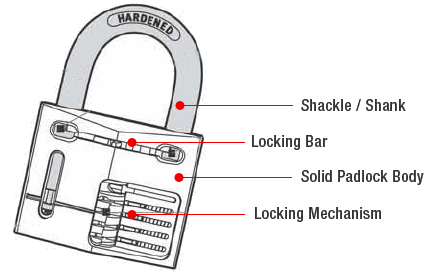Padlocks usually consist of a solid body, a locking mechanism and a shackle. There are various different styles but the basic design and operation is the same.
Most padlocks use solid metal bodies with the exception of disc padlocks and some combination padlocks. This is the strongest part of the padlock and as the size of the padlock increases then the larger the keyway and locking mechanism can be.
The keyway and locking mechanism usually contains between 3 and 7 small pins which are spring loaded. As the key entered the padlock barrel the different notches on the key allow the pins to be aligned correctly. Once aligned then the barrel can rotate, unlocking the shackle. Some padlocks use spring loaded shackles which will pop out when unlocked. Others have to be manually removed.

The shackle or shank is the U-shaped bar that loops round from, and back into, the padlock body. This is the most exposed part of the padlock and more susceptible to be attacked. Once again, as the overall size of the padlock increases, the larger the shackle can be making it more secure.
Some padlocks are designed differently and therefore have slightly different properties. We have a dedicated section explaining the different shapes, designs and the merits of each.
Other Information Sources: